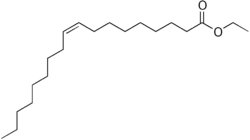Ethyl oleate
Ethyl oleate is a fatty acid ester formed by the condensation of oleic acid and ethanol. It is a colorless to light yellow liquid. Ethyl oleate is produced by the body during ethanol intoxication.[2]
 | |
| Names | |
|---|---|
| IUPAC name
Ethyl (Z)-octadec-9-enoate | |
| Other names
Oleic acid ethyl ester | |
| Identifiers | |
3D model (JSmol) |
|
| ChEBI | |
| ChEMBL | |
| ChemSpider | |
| ECHA InfoCard | 100.003.536 |
| KEGG | |
PubChem CID |
|
| UNII | |
CompTox Dashboard (EPA) |
|
| |
| |
| Properties | |
| C20H38O2 | |
| Molar mass | 310.522 g·mol−1 |
| Appearance | Colorless to light yellow liquid[1] |
| Density | 0.87 g/cm³[1] |
| Melting point | −32 °C (−26 °F; 241 K)[1] |
| Boiling point | 216–218 °C (421–424 °F; 489–491 K)[1] (15 hPa) |
| Insoluble[1] | |
| Hazards | |
| Flash point | > 113 °C[1] |
Except where otherwise noted, data are given for materials in their standard state (at 25 °C [77 °F], 100 kPa). | |
| Infobox references | |
Ethyl oleate is used as a solvent for pharmaceutical drug preparations involving lipophilic substances such as steroids.[3] It also finds use as a lubricant and a plasticizer. Louis Bouveault used ethyl oleate to demonstrate Bouveault–Blanc reduction, producing oleyl alcohol and ethanol,[4] a method which was subsequently refined and published in Organic Syntheses.[5]
Ethyl oleate is regulated as a food additive by the Food and Drug Administration under "Food Additives Permitted for Direct Addition to Food for Human Consumption", 21CFR172.515.
Ethyl oleate has been identified as a primer pheromone in honeybees.[6]
Ethyl oleate is one of the fatty acid ethyl esters (FAEE) that is formed in the body after ingestion of ethanol. There is a growing body of research literature that implicates FAEEs such as ethyl oleate as the toxic mediators of ethanol in the body (pancreas, liver, heart, and brain).[7][8][9] Among the speculations is that ethyl oleate may be the toxic mediator of alcohol in fetal alcohol syndrome.[7] The oral ingestion of ethyl oleate has been carefully studied and due to rapid degradation in the digestive tract it appears safe for oral ingestion.[10] Ethyl oleate is not currently approved by the U.S. Food and Drug Administration for any injectable use. However, it is used by compounding pharmacies as a vehicle for intramuscular drug delivery, in some cases to prepare the daily doses of progesterone in support of pregnancy. Studies which document the safe use of ethyl oleate in pregnancy for both the mother and the fetus have never been performed.
See also
References
- Record in the GESTIS Substance Database of the Institute for Occupational Safety and Health
- Dan L, Laposata M (1997). "Ethyl palmitate and ethyl oleate are the predominant fatty acid ethyl esters in the blood after ethanol ingestion and their synthesis is differentially influenced by the extracellular concentrations of their corresponding fatty acids". Alcohol. Clin. Exp. Res. 21 (2): 286–92. doi:10.1111/j.1530-0277.1997.tb03762.x. PMID 9113265.
- Ory SJ, Hammond CB, Yancy SG, Hendren RW, Pitt CG (1983). "The effect of a biodegradable contraceptive capsule (Capronor) containing levonorgestrel on gonadotropin, estrogen, and progesterone levels". Am. J. Obstet. Gynecol. 145 (5): 600–5. PMID 6402933.
- Bouveault, Louis; Blanc, Gustave Louis (1904). "Hydrogénation des éthers des acides possédant en outre les fonctions éther-oxyde ou acétal" [Hydrogenation of the ether of the acids furthermore possessing the ether-oxide or acetal functions]. Bull. Soc. Chim. Fr. (in French). 31 (3): 1210–1213.
- Adkins, Homer; Gillespie, R. H. (1949). "Oleyl alcohol". Organic Syntheses. 29: 80. doi:10.15227/orgsyn.029.0080.; Collective Volume, 3, p. 671
- Leoncini I.; Le Conte, Y; Costagliola, G; Plettner, E; Toth, AL; Wang, M; Huang, Z; Bécard, JM; et al. (2004). "Regulation of behavioral maturation by a primer pheromone produced by adult worker honey bees". Proc. Natl. Acad. Sci. U.S.A. 101 (50): 17559–17564. doi:10.1073/pnas.0407652101. PMC 536028. PMID 15572455.
- Laposata M. (1998). "Fatty acid ethyl esters: nonoxidative metabolites of ethanol". Addiction Biology. 3: 5–14. doi:10.1080/13556219872308.
- Laposata M. (1999). "Fatty acid ethyl esters: current facts and speculations". Prostaglandins, Leukotrienes and Essential Fatty Acids. 60 (5&6): 313–315. doi:10.1016/S0952-3278(99)80005-2.
- Laposata M, et al. (2002). "Fatty acid ethyl esters: recent observations". Prostaglandins, Leukotrienes and Essential Fatty Acids. 67 (2–3): 193–196. doi:10.1054/plef.2002.0418.
- Saghir M. (1997). "Rapid in vivo hydrolysis of fatty acid ethyl esters, toxic nonoxidative ethanol metabolites". Am J Physiol. 273: G184–190.